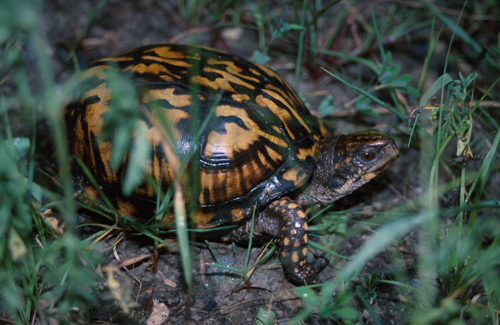The eastern box turtle is medium-sized turtle. Its shell, or carapace, is highly domed and patterned with orange or yellow on a brown or black background. The bottom shell, or plastron, is hinged so the turtle can withdraw itself completely within its shell and close the openings. About 90% of male box turtles have red eyes. The females have brown eyes. The carapace of eastern box turtles measures 4 to 8 1/2 inches long.
Eastern box turtles range from southern Maine south to the Florida Keys and west to Michigan, Illinois and Tennessee. There are other subspecies with different ranges, such as the western box turtle which is found further west in the US. Eastern box turtles are found in the low-lying areas of Connecticut and here are rarely observed at elevations over 700ft.
Eastern box turtles are terrestial. They inhabit deciduous woods or overgrown fields that provide both cover and ample sunlight. These turtles are still dependent on wetlands where they go to drink and to escape periods of heat and drought.
In New England eastern box turtles breed from April to the fall. They nest in late June. Females lay 3 to 8 elliptical eggs with thin shells. Females migrating to a nesting site are vulnerable to being run over as they cross roads. The deep, flask-shaped nesting cavity is dug in loose or sandy soil. The eggs hatch in late summer or early fall and hatchlings may overwinter inside the nest. These turtles reach sexual maturity in 10 years or longer. The females can store sperm from one mating up to 4 years and use it to produce fertilized eggs. Eastern box turtles have a lifespan comparable to a human's, and some may live over 100 years.
From about October to April New England eastern box turtles hibernate. They may burrow in loose soil or vegetation in or near woodlands. The same hibernation spot may be used for years. Eastern box turtles may be seen out in the early morning or just after a rain. In the heat of the day they retreat to swampy areas.
Eastern box turtles are omnivores. Their diet includes slugs, earthworms, and wild strawberries. They eat mushrooms that are poisonous to humans and this can make their flesh poisonous to humans as well.
The length of time to sexual maturity, low egg production and mortality rate of adult turtles makes the sustainability of the eastern box turtle population uncertain. They are a species of Special Concern in Connecticut.
